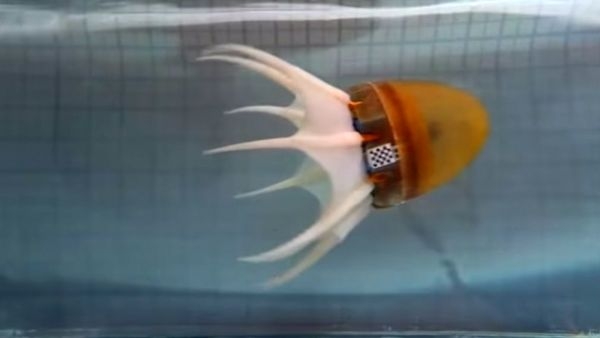
Software robots are not a very mainstream concept in robotics, but now more and more research institutions are researching this new type of robot. The image of movies is the most typical representation of software robots.
A few days ago, researchers from the School of Physics of Warsaw University in Poland successfully developed a 15 mm software robot.
This is a soft robot made from liquid crystal elastomers (LCEs). LCEs change shape when exposed to visible light. If you feel the light source of the outside world, the shape of the robot will change and become like a caterpillar. With light irradiation, the body will also shrink accordingly and then push the body to move.
It is understood that through the control of the light source, the software robot can perform various special tasks, such as climbing steep slopes and drilling into extremely small spaces. The most uncanny thing is that although it is not large in size, it can move a lot more than it does. A 10x object can even be used for espionage if a camera or microphone is mounted on this robot.
What is the difference between software robots and traditional robots?
Popular point of view, soft robot is a kind of flexible robot, its model mostly comes from the natural world of soft organisms, such as robotic snakes, marine aquatic animal robots and so on.
material
The soft body robot's materials are mainly flexible materials instead of the traditional rigid connectors and shells. The simplest method is to use 3D printing.
Driving method
Theoretically speaking, it is possible to move an object that is 100 times larger than its own weight, so its principle of motion is also very special. The entire robot does not need to be driven by traditional motor and other power devices. The current research institutions mainly have two directions: The first method is The second is to use the changes in the environment to obtain power, such as temperature, air and light.
Software robots have many advantages over rigid robots. They can adapt to various environments better, and they will not cause major harm after being subjected to external shocks. They can accomplish complex tasks in small and unstructured environments, such as medical care. , military and detection. In addition, the material can be produced using 3D printing, etc., and the cost is much lower than that of rigid robots. According to industry insiders, software robots have more computing power than rigid robots and are as important as liquid metal robots.
Form control
Because the structure and material of the software robot are non-linear and have many degrees of freedom, this results in the robot's motion task being more complicated than the rigid robot. This has a very high requirement for the algorithm. At present, morphological calculation is a research direction, it can achieve a variety of physical models. It can be understood that the morphological calculation is that the robot's body can realize the calculation task without external algorithms.
Lei Fengnet (search for "Lei Feng Net" public concern) once introduced Daniela Rus, director of the MIT Computer Science and Artificial Intelligence Laboratory (MIT CSAIL), on the research of robots, while MIT and Harvard University are softwares. The two most powerful universities in the field of robotics. It is foreseeable that these small and beautiful software robots will be applied to more and more fields as the difficulties of robotics are gradually overcome.
Recommended reading:
Entering the Octopus Robot: This Octopus Guides the Future of Software Robots
Daniela Russ: An AI woman in the artificial intelligence community founded two artificial intelligence labs